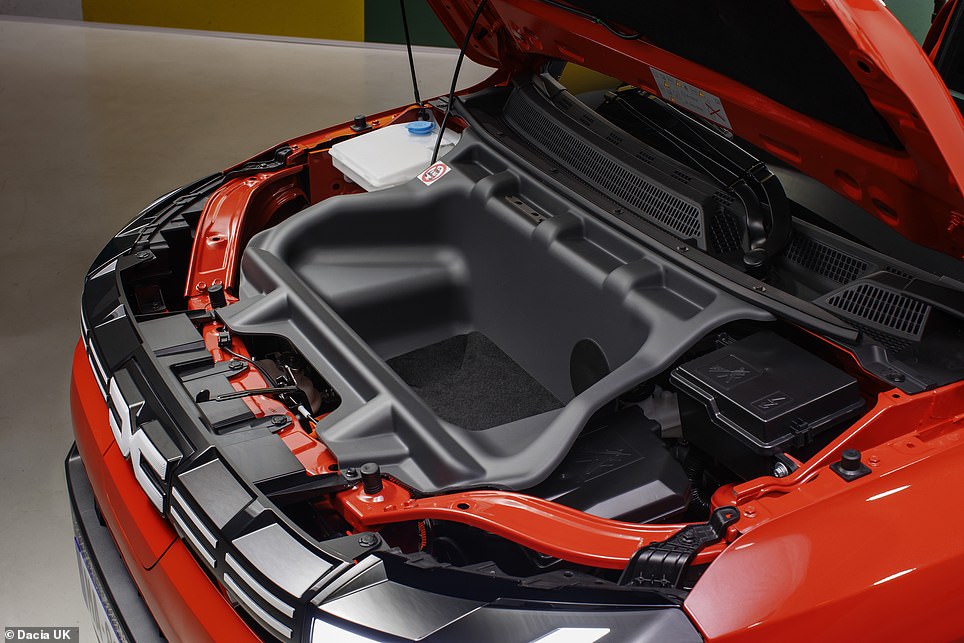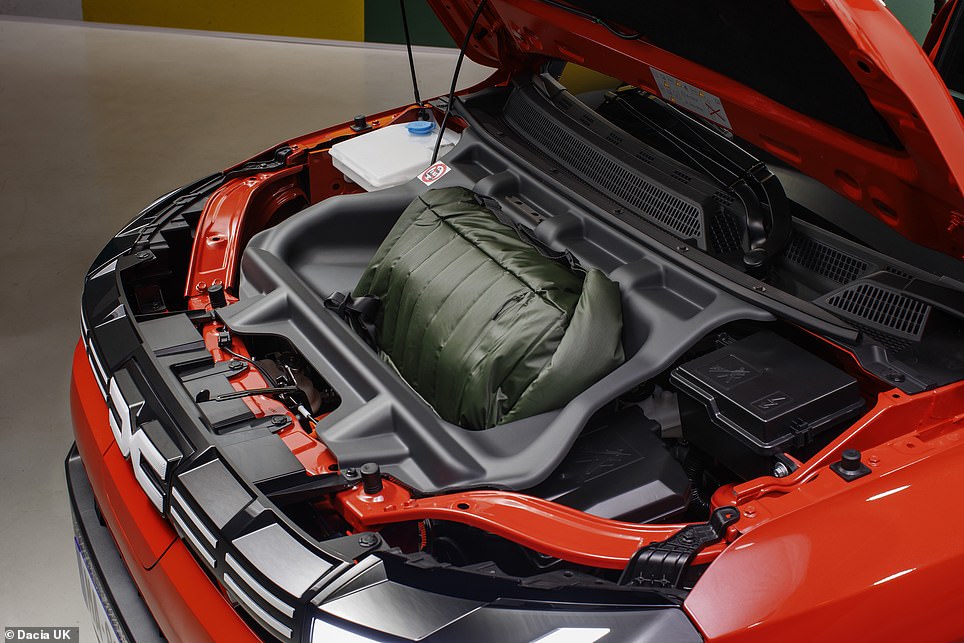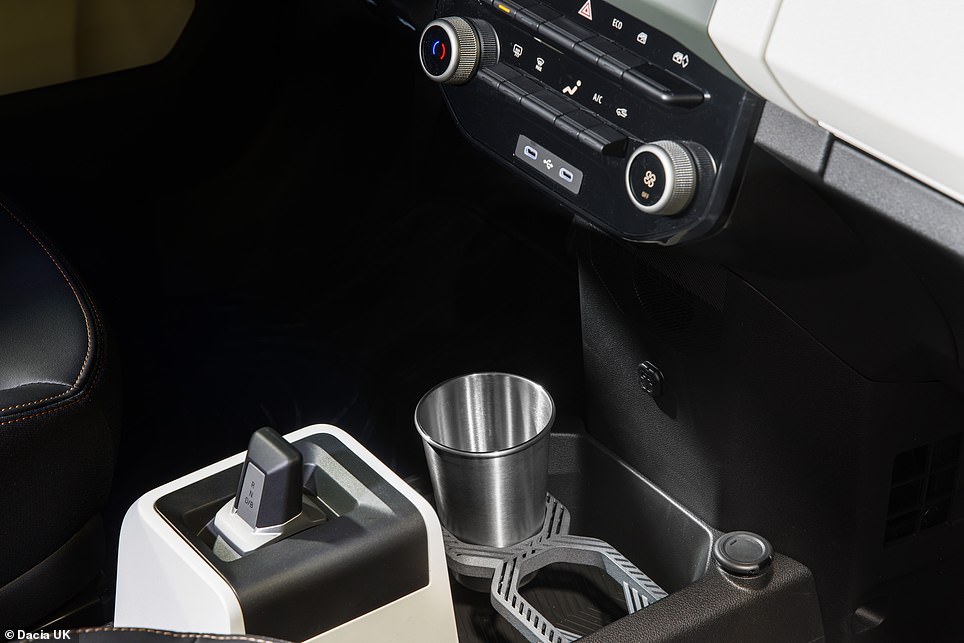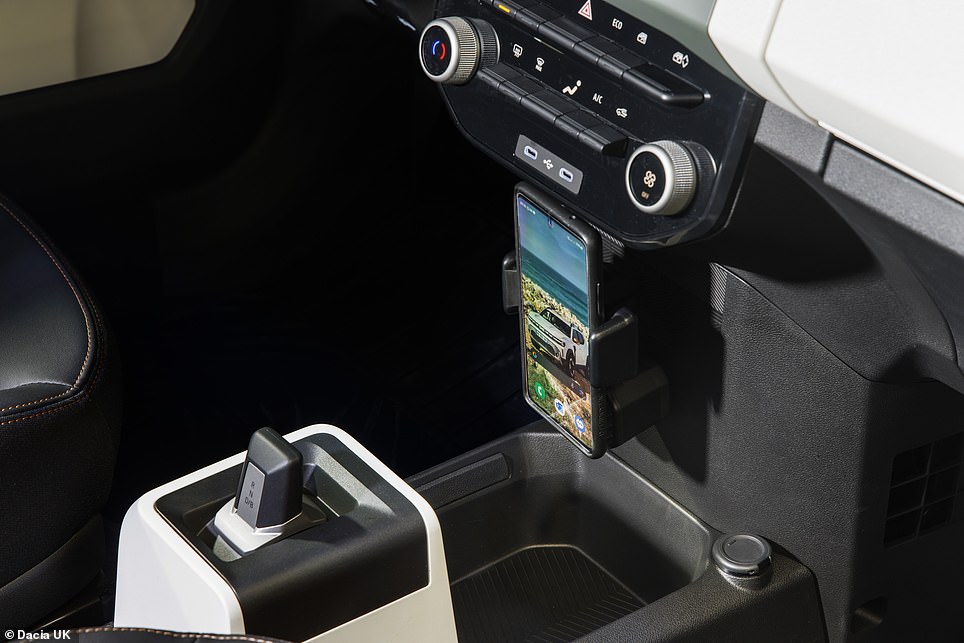Britons will soon be able to get their hands on an affordable electric car, as budget-friendly brand Dacia has confirmed its Spring EV will go on sale in Britain next month.
The small battery-powered hatchback has been in showrooms in mainland Europe since 2021, but bosses at parent group Renault had been reluctant to launch the low-cost EV in the UK… until now.
From March, order books will open for the Spring in Britain, just in time for the chunky compact car to get a mid-life facelift with a fresh look and new trim levels.
And while prices won’t be confirmed until it officially goes on sale on 12 March, it’s speculated to undercut the current cheapest electric car by almost £10,000.
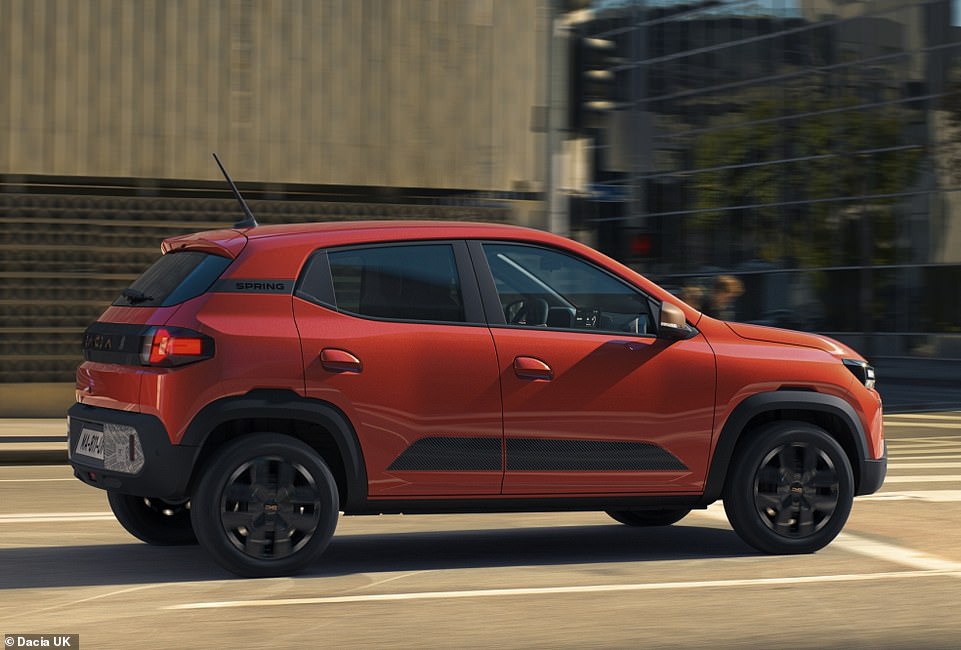
Britain’s cheapest EV: This is the new Dacia Spring – a compact electric car that’s set to move the goalposts when it comes to affordability of battery models
How ‘affordable’ will it really be?
Dacia says the pillar of Spring’s original concept is to be a ‘widely affordable’ fully electric car that’s adapted to the real needs of drivers.
It promises it will be the ‘most affordable full-electric car on the market’ with the aim to ‘encourage UK motorists to transition to electric driving in a very concrete and effective way’.
While prices won’t be confirmed until the middle of next month, we have it on good authority that the starting price for the cheapest version with the least powerful electric motor will start from less than £18,000.
The least expensive EV on sale in Britain today (not including the Citroen Ami quadricycle) is the MG4, which starts from £26,995.
While the MG is somewhat larger and represents great value, the Spring will take the title of the nation’s most affordable EV by some margin.
Its most comparable battery vehicle on sale right now is Fiat’s 500, which starts from a significantly pricier £28,195.
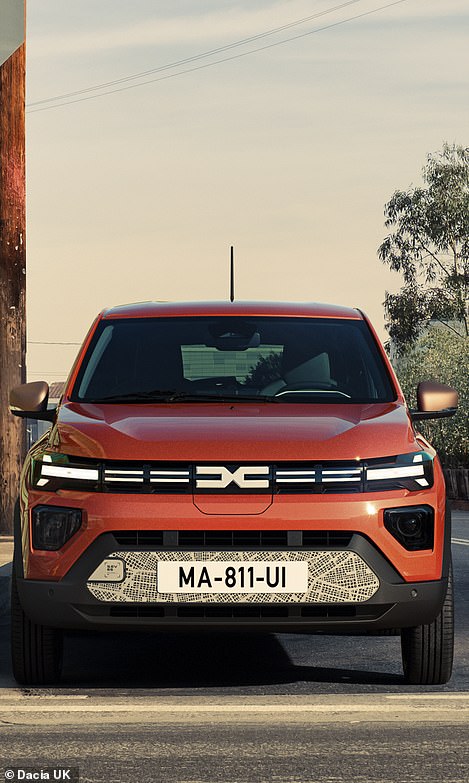
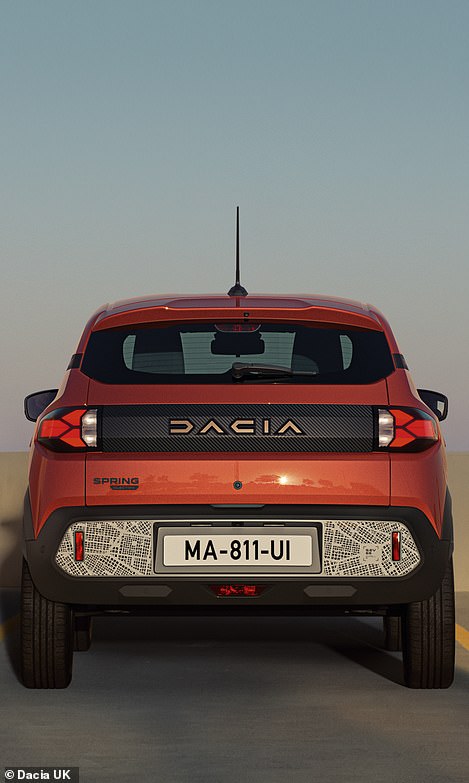
The small battery-powered hatchback has been in showrooms in mainland Europe since 2021, but bosses at parent group Renault had been reluctant to launch the low-cost EV in the UK. But that will all change in 2024, with order books opening for this facelifted version in March
What’s the range of such an inexpensive EV?
Dacia says its first all-electric model has been ‘widely credited for making electric mobility accessible to all’ in the countries where it’s been on sale since 2021 – and it’s been snapped up in big numbers since being available on the continent.
Spring was the third most sold electric car to ‘retail customers’ in 2022 and 2023, accumulating more than 140,000 global sales in the last two years.
The ‘all-new’ Spring sold to UK customers from next month is said to ‘achieve greater efficiency through its light weight’. And it’s certainly that.
Tipping the scale at just 984kg, it’s the only EV on sale in Europe that’s less than a tonne.
As such, it doesn’t need an enormous battery pack to achieve the range Dacia deems fit for a car of these proportions.
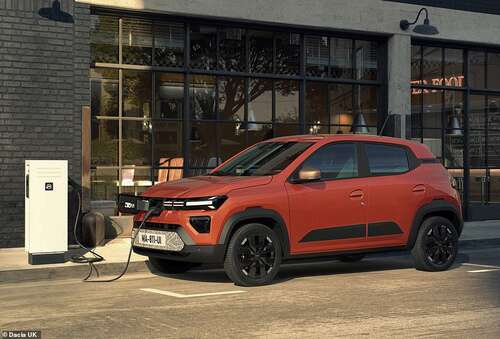
But Dacia says the battery size has been ‘precisely calibrated to meet the needs and lifestyles of Spring drivers, without degrading the overall performance by adding excessive weight’. That’s why it is expected to achieve an official range of ‘over 137 miles’
The battery is just 26.8kWh.
To put that into perspective, the largest in an EV sold in Britain today is four times bigger – the 120kWh pack in the £100,000 Mercedes-Benz EQS 450+.
But Dacia says the battery size has been ‘precisely calibrated to meet the needs and lifestyles of Spring drivers, without degrading the overall performance by adding excessive weight’.
That’s why it is expected to achieve an official range of ‘over 137 miles’.
That doesn’t sound much, especially when you take into account that under real-world driving conditions you will do well to achieve 90 per cent of that figure, but bosses say this is more than suitable for Spring buyers.
What justification does it have for such a claim?
Well, the company has been collecting data from on-board computers of Springs sold across Europe and found that the average owner drives just 23 miles per day.
The customer information it has downloaded also shows that a Spring travels mostly in town at an average speed of only 23mph. And in three in four cases, the cars are recharged at home rather than using the public network.
The facelifted model also comes upgraded with regenerative braking for the first time, with the automatic gear selector now including a ‘B-mode’, which noticeably slows the vehicle via the regenerative system to feed energy back into the battery.
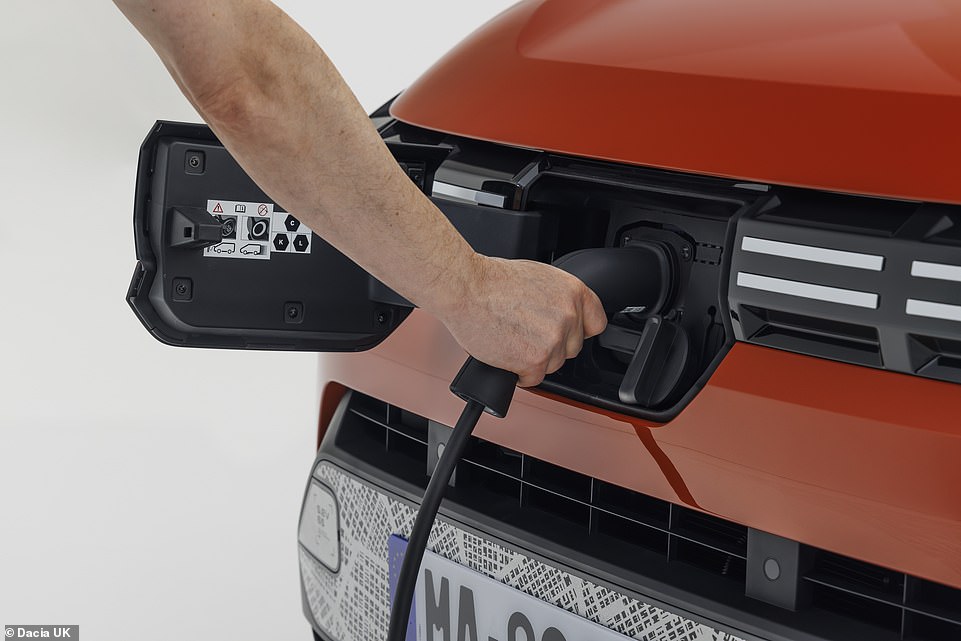
Dacia has been collecting data from on-board computers of Springs sold across Europe since 2021 and found that the average owner drives just 23 miles per day. Some 75% are also charged at home. This is why the Spring will have a range under 140 miles
As standard, the Spring will come with a 7kW AC charger that can charge the battery from 20 per cent to 100 per cent on a domestic three-pin plug in less than 11 hours, or in just four hours via a 7kW homecharger.
A 30kW DC charger enables fast charging from 20 per cent to 80 per cent in 45 minutes if you plug into a public rapid-charging device.
And Dacia has even equipped the UK-spec Spring with a bi-directional V2L (vehicle-to-load) charger.
This means it comes with an adapter that plugs into the car’s charging connector, which is located under the grille, that can be used as a conventional 220V/16A socket for appliances.
It then can be used as an energy source to power electrical devices, such as a laptop, kettle or even a microwave.
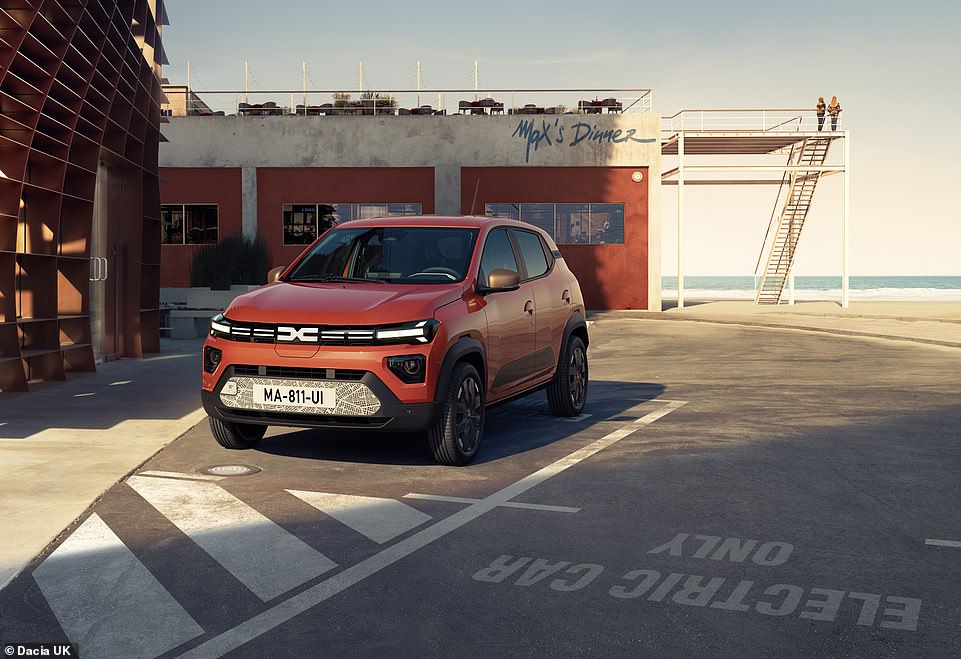
As standard, the Spring will come with a 7kW AC charger that can charge the battery from 20 per cent to 100 per cent on a domestic three-pin plug in less than 11 hours, or in just four hours via a 7kW homecharger
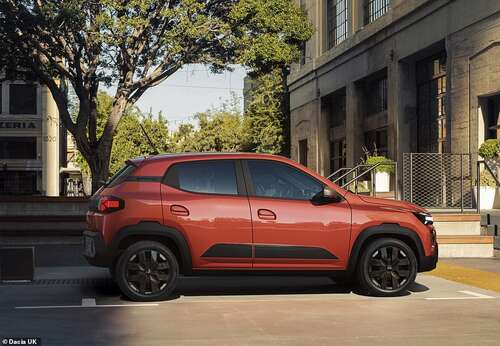
The Spring’s battery size is just 26.8kWh. To put that into perspective, the largest in an EV sold in Britain today is four times bigger – the 120kWh pack in the £100,000 Mercedes-Benz EQS 450+
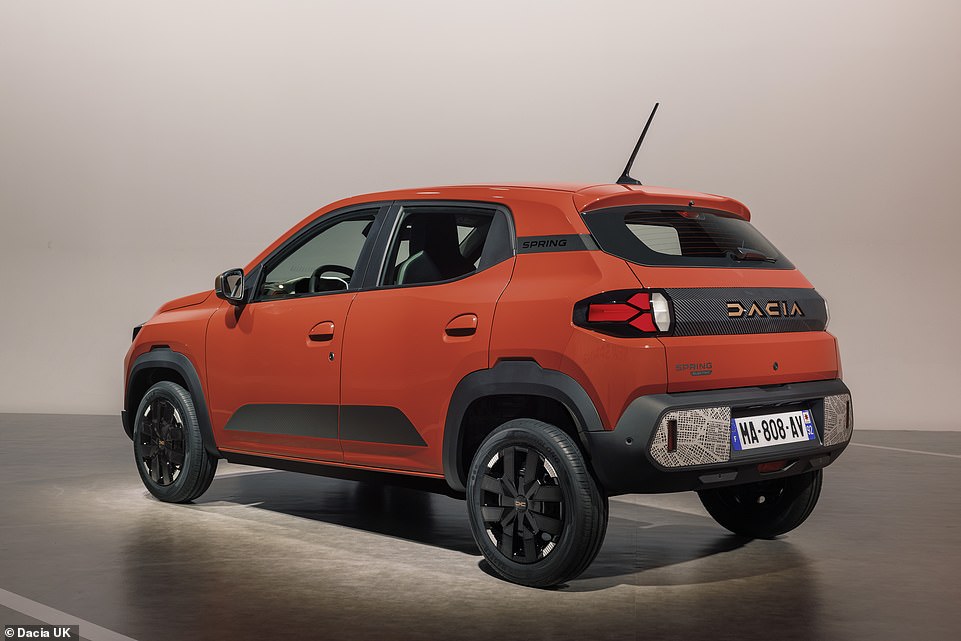
While it might be eco friendly, the Spring won’t be quick. Of the two power outputs available, the most potent takes a pedestrian 14 seconds to reach 62mph from a standstill. That’s particularly slow by EV standards
So green is the Spring that its energy efficiency and carbon footprint received high praise in 2022, when it was awarded the maximum 5-star rating from the independent European organisation Green NCAP.
But while it might be eco friendly, it’s not what you’d call fast.
It will be available with a single electric motor with two power outputs: 45hp and 65hp.
The more potent of the two takes a pedestrian 14 seconds to reach 62mph from a standstill, which is particularly slow by EV standards.
How practical is the Dacia Spring?
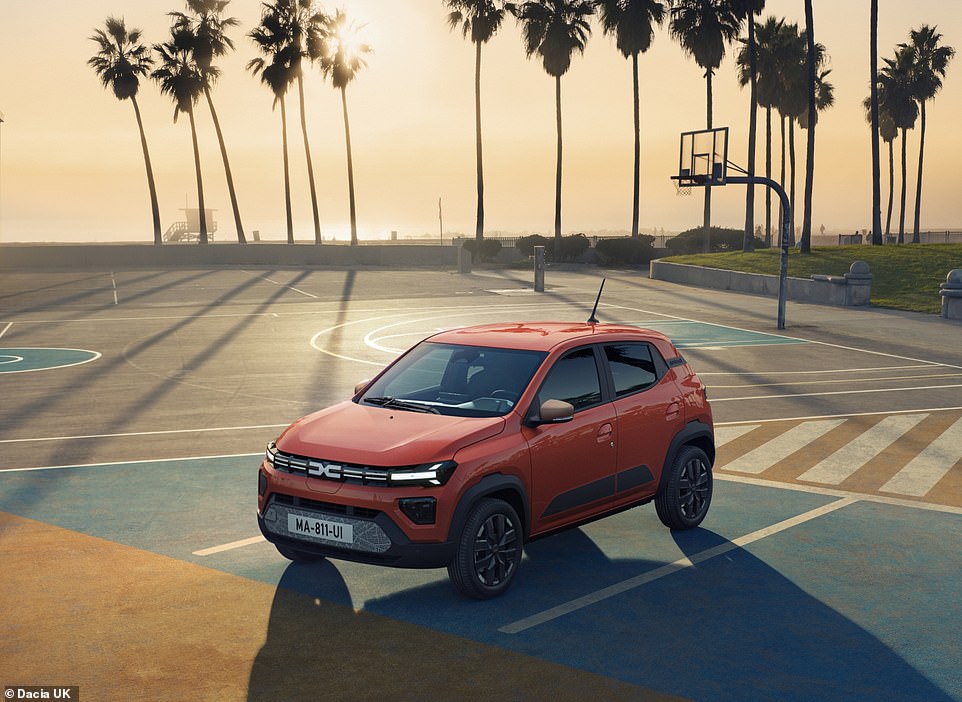
At just 3.7 metres long, it’s shorter than Dacia’s Sandero supermini. This will be ideal for inner-city jaunts, with a turning circle of just 4.8 metres making it exceptionally agile and easy to plug into the smallest of parking spaces
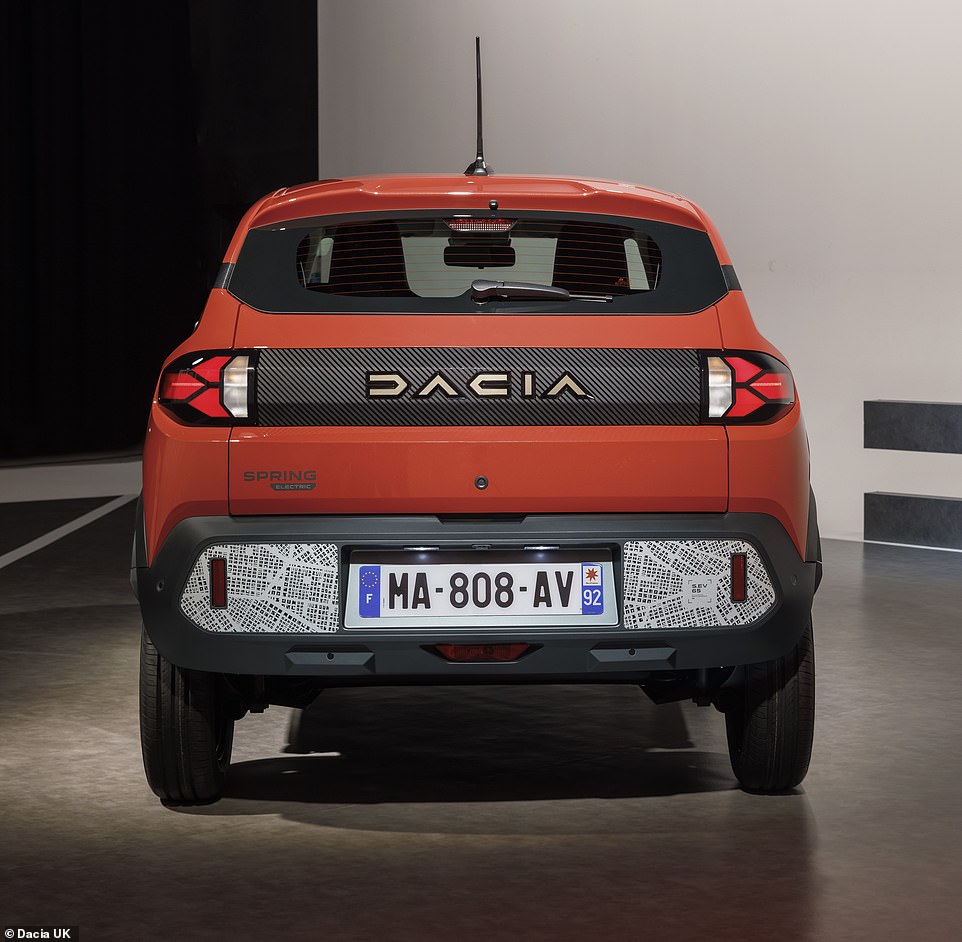
The Springs elevated ground clearance allows for customers to ‘venture over rough terrain,’ says Dacia – though we wouldn’t recommend taking on any mountains or ravines, given it’s only available with two-wheel drive
Don’t be fooled by the Spring’s SUV-inspired looks – this is far from an enormous Chelsea Tractor.
At just 3.7 metres long, it’s shorter than Dacia’s Sandero supermini.
This will be ideal for inner-city jaunts, with a turning circle of just 4.8 metres making it exceptionally agile and easy to plug into the smallest of parking spaces.
In particularly tight scenarios, owners will be comforted by the fact the Spring’s bumpers and wheel arches have plastic protection strips.
This is so that the small EV can ‘withstand everyday wear and tear without compromising on appearance,’ bosses say.
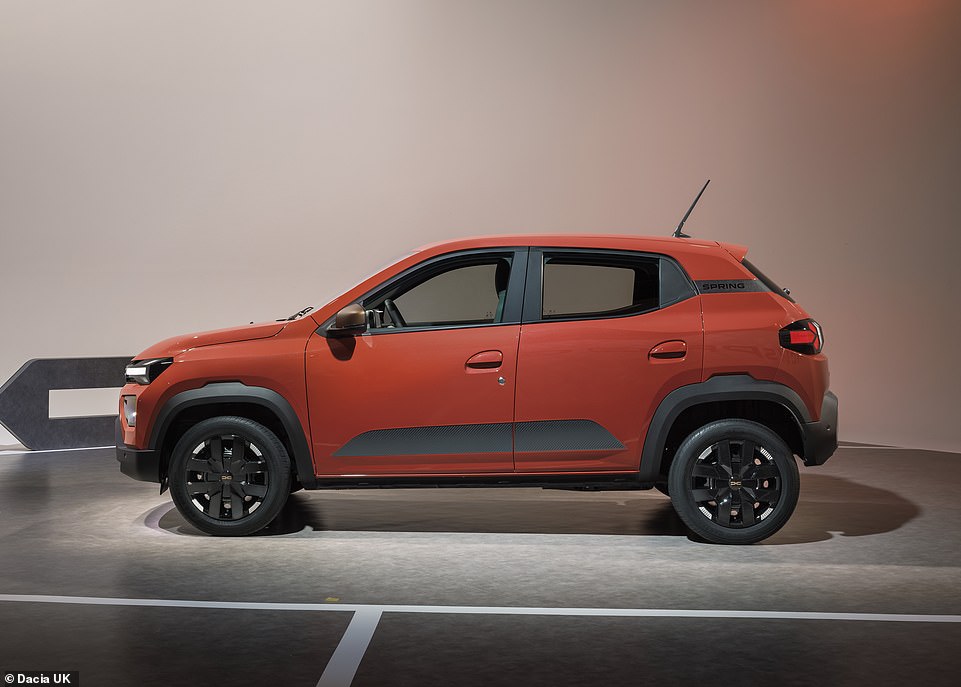
The Spring’s boxy proportions give a chunky, robust feel, which is bolstered by square wheel arches over the 15-inch wheels
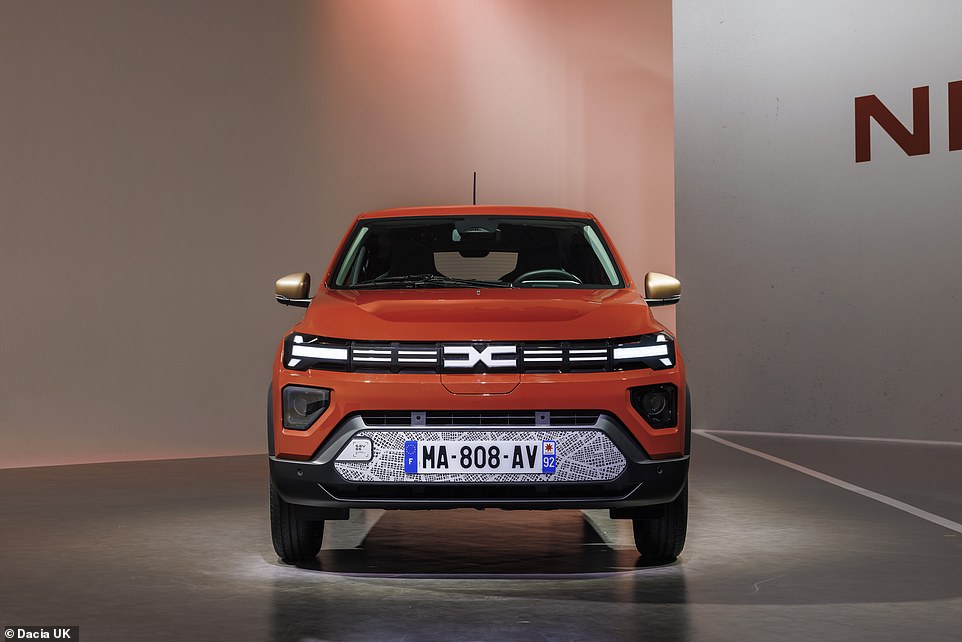
Owners who often try to squeeze into tight parking spaces will be comforted by the fact the Spring’s bumpers and wheel arches have plastic protection strips. This is so that the small EV can ‘ withstand everyday wear and tear without compromising on appearance,’ bosses say
Its high ground clearance also allows for customers to ‘venture over rough terrain,’ says Dacia, though we wouldn’t recommend taking on any mountains or ravines, given it’s only available in two-wheel-drive.
While its small dimensions will be to the benefit of ease of driving in the city, the compromise will be interior passenger space.
If similar to the pre-facelift Spring, expect there to be limited room in the rear, which is likely to be cramped for taller-than-average adults.
While its small dimensions will be to the benefit of ease of driving in the city, the compromise will be interior passenger space.
As well as a class-leading boot, the Spring also has some storage space up front. Customers will also be able to access 35 litres of ‘luggage’ capacity under the bonnet
That said, Dacia claims it has the best storage volume in its class.
The boot offers 308 litres of loading space – 1,004 litres with the rear seats folded down – and has additional storage throughout the cabin, with an overall volume of nearly 33 litres.
Customers will also be able to access 35 litres of ‘luggage’ space under the bonnet.
Will it have a better safety rating that other Dacias?
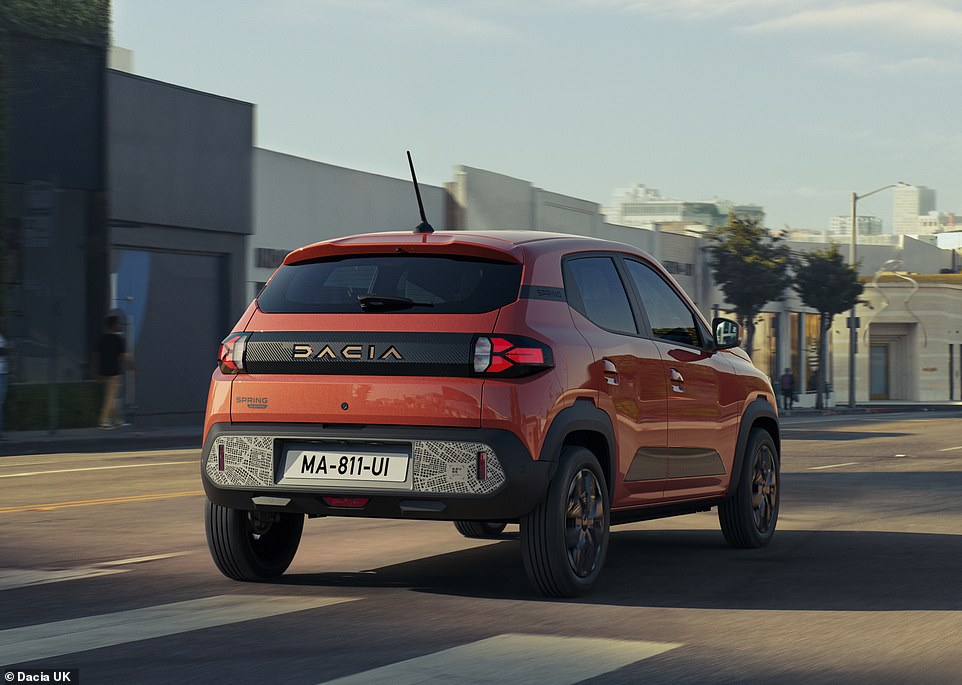
The Spring will be sold as standard with an updated emergency braking system with detection for vehicles, pedestrians, cyclists and motorcycles. This should mean it should get a higher Euro NCAP crash test rating than some of its sister models
One of the big criticisms of Dacia models of late – particularly the Sandero – is its low Euro NCAP crash test rating.
However, this is primarily due to it lacking passive safety tech as standard.
That won’t be the case with the Spring.
It will come with an updated emergency braking system with detection for vehicles, pedestrians, cyclists and motorcycles.
The suite of safety features also include traffic sign recognition with speed alert, rear park assist, emergency stop signal, lane change alert, lane keep assist, driver attention warning and emergency call (eCall) in case of accidents and an ambulance or the police needing to be contacted.
Will it feel cheap?
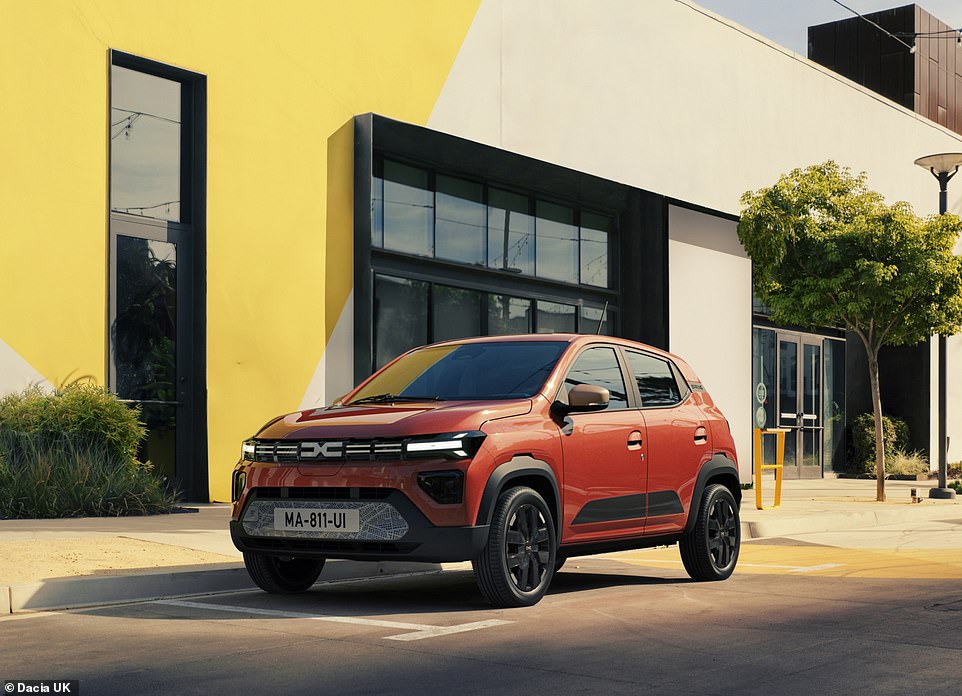
The Dacia Spring will share the brand’s Y-shaped light signatures front and back, with full-LED daytime headlight
Plenty of drivers have turned their noses up at the prospect of buying a Dacia due to its no-frills asking prices.
Yet, the latest examples of its Sandero, Duster and Jogger are not just well equipped, they offer generally solid cabins, if not loaded with the latest tech.
They also look pretty smart too, which – from the images seen here – is set to continue with the Spring.
It features the brand’s Y-shaped light signatures front and back, with full-LED daytime headlights.
The boxy proportions give a chunky, robust feel, which is bolstered by square wheel arches over the 15-inch wheels.
There is lower-door side protection that can be easily removed and replaced in case of any car park dings and there are are decals instead of chrome badges and lettering as part of the effort to make it as lightweight as possible – and to keep costs down.
Dacia says it doesn’t come with roof bars like some small crossover rivals because ‘they are generally redundant on a small car used mainly for short trips,’ and by removing them again helps to trim its bulk and extend its driving range.
It will come in a range of six shades, including newly introduced Brick Red and Beige Safari.
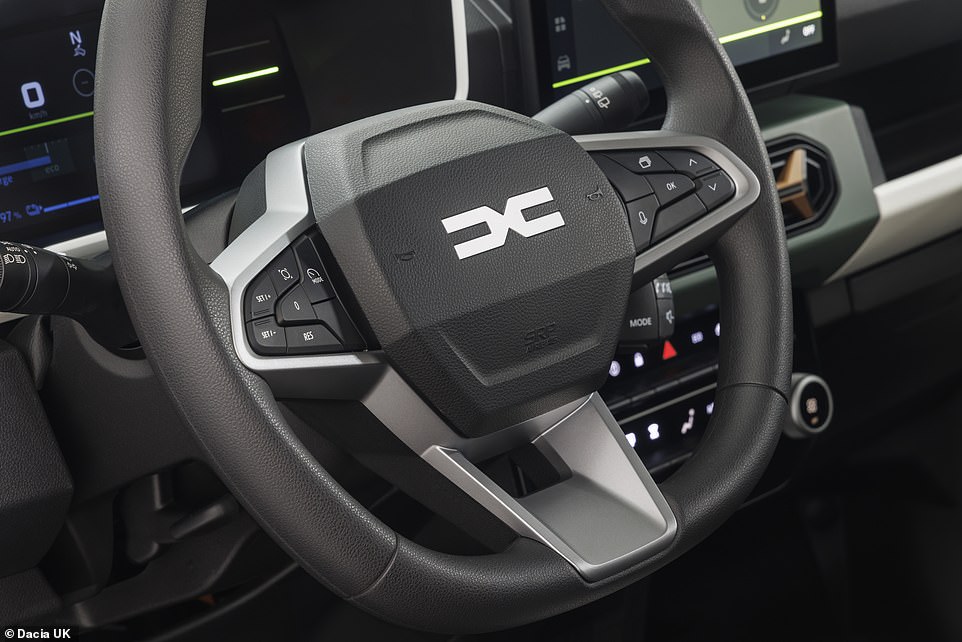
Basic trim levels come with just a 7-inch digital instrument cluster. Buttons on the steering wheel control the multimedia system with media information and phone calls displayed on the driver’s display
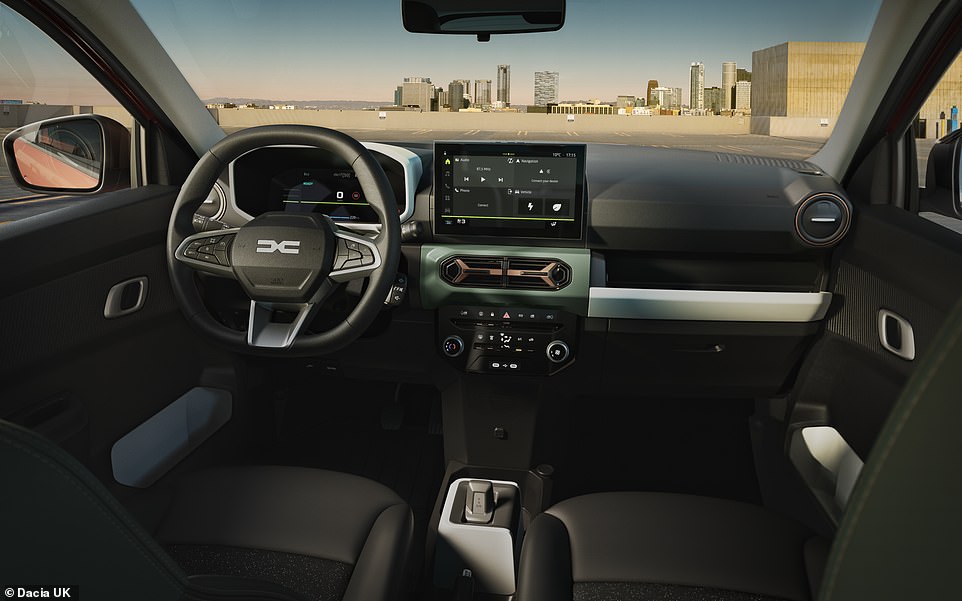
Higher trims get a 10-inch central touchscreen, which includes ‘smart navigation’ that has real-time traffic conditions and up-to-date European maps for up to eight years
Inside, it’s designed to be durable yet efficient and clever.
Basic trim levels come with just a 7-inch digital instrument cluster.
Buttons on the steering wheel control the multimedia system with media information and phone calls displayed on the driver’s display.
It also incorporates two speakers, a Bluetooth connection, and a USB port.
When connected to the free Dacia Media Control app, drivers can use radio and media functions and access other features – including navigation – via their smartphone.
Higher trims get a 10-inch central touchscreen, which includes ‘smart navigation’ that has real-time traffic conditions and up-to-date European maps for up to eight years.
The infotainment screen also enables wireless use of Apple CarPlay and Android Auto and comes with a pair of USB ports.
The lower section of the centre console can also be used as a cup holder, thanks to a 3D-printed inset. It also comes with Dacia’s YouClip accessory mount, which can carry a smartphone or other devices
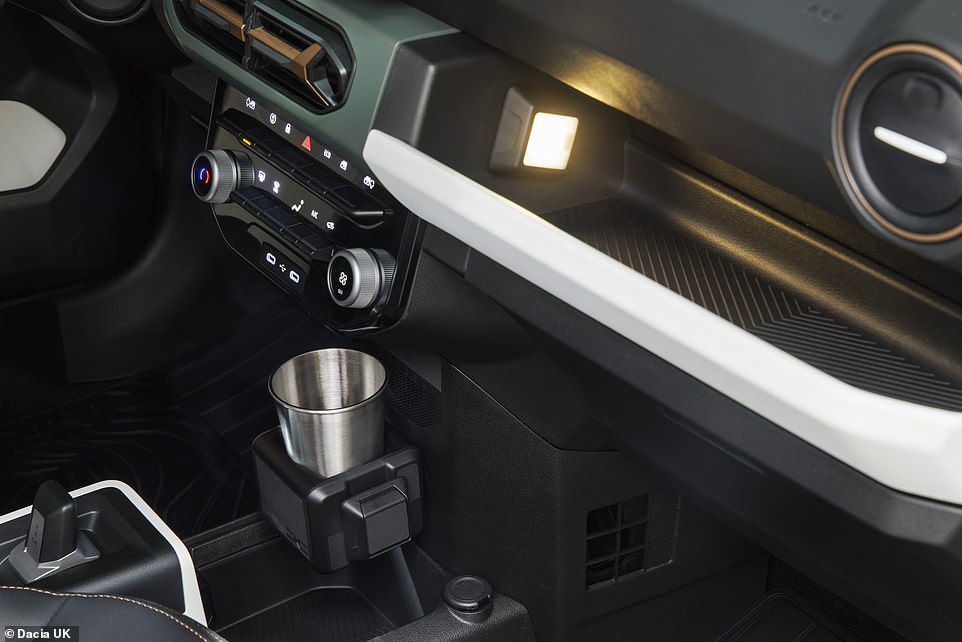
Another handy feature is the tray sitting above the glovebox, which has it’s own light so passengers can find their phone or house keys stashed there in the dark
The lower section of the centre console can also be used as a cup holder, thanks to a 3D-printed inset, and there’s space for Dacia’s YouClip accessory mount, which can carry a smartphone or other devices.
Another handy feature is the tray sitting above the glovebox, which has it’s own light so passengers can find their phone or house keys stashed there in the dark.
Speaking about the Spring’s unveiling, David Durand, Dacia design director, commented: ‘As Spring embraces the brand’s new design language, it is a resolute sign that it is here to stay as a key member of the Dacia family.
‘We gave it a serious and confident design. Building on the success of the previous generation, the All-New Spring confidently asserts its own identity.’
Some links in this article may be affiliate links. If you click on them we may earn a small commission. That helps us fund This Is Money, and keep it free to use. We do not write articles to promote products. We do not allow any commercial relationship to affect our editorial independence.
